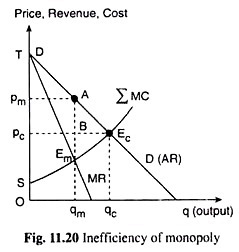We shall now try to measure the net welfare loss due to monopoly or inefficiency of monopoly.
In Fig. 11.20, the price-output solution under perfect competition is Ec (pc, qc) and that under monopoly is Em (pm, qm). The level of output of the perfectly competitive industry is the efficient level of output because here the willingness to pay for an extra unit of output just equals the cost of producing the extra unit (p = MC).
Under monopoly, on the other hand, activity stops at a point where p is greater than MC, i.e., the willingness to pay for an extra unit is greater than the cost of producing the extra unit. That is why the monopoly output level is inefficient.
ADVERTISEMENTS:
If we move from the competitive output level qc to the monopoly output level qm, i.e., if we move from the point Ec to the point A along the demand curve there occurs a loss in consumers’ surplus, which is measured by □pcAEc, and the producer’s surplus decreases by □BEmEc and increases by □pcpmAB which is a part of the loss in consumers’ surplus.
It appears, therefore, that as we move from perfect competition to monopoly, the surplus equal to □pcpmAB is transferred from the consumers to the monopolist producer. We cannot evaluate the net gain or loss in welfare, if any, that would result from this transfer unless we are provided with some extra value judgement to overcome the problem of interpersonal comparison of utility.
In the absence of this, we may simply assume that the surplus is transferred from the consumers to the owner(s) of the industry, and this transfer has not given rise to any net gain or loss in welfare to the society.
However, the loss in producer’s surplus equal to □BEmEc and the □AEcB portion of the loss in consumers’ surplus cannot be accounted for as having been transferred to any other group(s) of individuals in the society.
ADVERTISEMENTS:
Therefore, the sum of these two areas, i.e., □AEmEc, represents the net loss in welfare to the society due to monopoly, or, the deadweight loss of monopoly, as it is called. The greater the deadweight loss caused by a change in the organisation of an industry from perfect competition to monopoly, the greater would be the inefficiency of monopoly.
